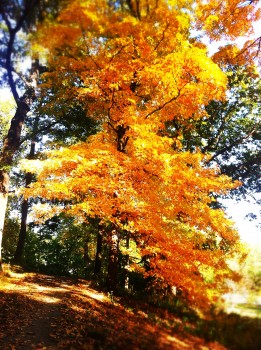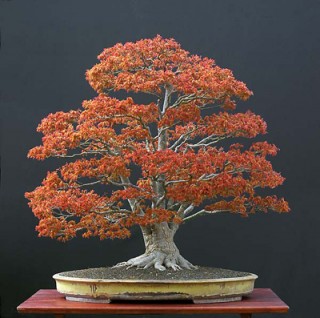Yesterday we were blessed with an absolutely splendid autumn day. Wanting to get out of the city and enjoy nature, the husband and I ventured to a nearby arboretum to enjoy the wonderful afternoon. The temperature was pleasantly cool, but a bright sun warmed the red-gold leaves of trees just beginning to turn. The spicy, earthy scent of pine needles was thick on the air, a promise of cooler nights to come.
As we walked, we stumbled across a collection of bonsai that were donated to the arboretum nearly a hundred years ago by a former ambassador to Japan. I don’t know much about bonsai, but I’ve always harbored a curiosity about the tiny twisting trees. Although these bonsai varied in size and type–cypress, cherry, and even a Japanese maple with tiny spiked leaves as red as blood–they all seemed to possess a gravity and elegance belied by their small size. And that’s when I realized how ancient the bonsai were.
Each potted tree bore a small plaque describing its taxonomy. But beneath that description, in tiny printed letters, was the age of the tree. When it had first been planted; how long it had been nurtured and cultivated. And I couldn’t believe my eyes when I saw some of the numbers. 1966. 1859. 1726. In case you don’t feel like doing the math, that means that some of those trees were over 280 years old. For hundreds of years, these tiny trees have been carefully cultivated; sculpted, trimmed, watered, cared for. Generations of botanists have spent their lives tending these ancient dwarves; trees older than most grown forest trees; trees older even than our nation.
Bonsai exemplify the Japanese aesthetic tradition known as wabi-sabi. Wabi-sabi is a worldview centered around transience and incomplete, imperfect beauty. Derived from Buddhist principles of impermanence, the concept of wabi-sabi nurtures all that is authentic by acknowledging that nothing lasts, nothing is finished, and nothing is perfect. Thus, the minimalist aesthetic of bonsai is meant to inspire in the observer a feeling of melancholy and spiritual longing as they consider the impermanence of all things. For me, this was a very tangible feeling, although I did not yet know the word for it; considering the bonsai made me think of all the nameless people who had grown old while the miniature tree stayed precisely the same. But more importantly, the bonsai made me remember that sometimes things don’t happen overnight.
My inclination in this life is to rush things. I want everything to happen now; I want the future to hurry up and happen. But sometimes things take time. Some things need to be carefully tended for long stretches of time before they attain any sort of beauty or meaning. A friendship; a fitness goal; a novel. Often, patience means acknowledging that not everything is perfect the first time around. Time is not the enemy; time simply is. So why not sit back and enjoy the ride? Planting seeds for the future doesn’t mean you have to ignore the beautiful foliage of trees already growing.
Have you ever contemplated impermanence? Do you admire bonsai? Leave your thoughts in the comment section below!


0 Comments